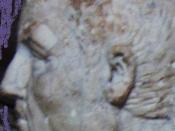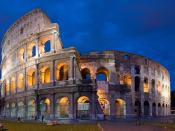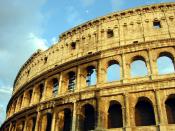PART 1.How did the design of the Colosseum relate to its public function and to its symbolic meaning? Answer in no more than 300 words.
The Amphitheatrum Flavium was a 'gift' to unite the citizens of Rome by the Emperor Vespasian, successor to Nero. Disliked by the citizens, Nero had taken vast amounts of land after the great fire; indeed the Colosseum was built on the site of Nero's 'resented palace' (Block 2, p.39). We can therefore assume that the Colosseum was not only a political gesture but a symbol of Imperial Rome and an arena for public events namely 'The Games'.
According to Vitruvius (Block 2, p.54) Roman architecture required 'commodity', 'firmness' and 'delight'; the Colosseum satisfied these functions in its design. Its elliptical shape provided excellent visibility of the arena; and used segregated seating within sectors according to social rank, ranging from Emperor to slave. Spectator comfort was provided by water fountains and the 'velarium' a large awning which could be drawn across the arena, providing shade (commodity).
The symbolic meaning of the Colosseum is evident in its design; firstly its sheer size, even today it dominates Rome's panorama. Its construction uses a honeycomb of walls and pillars (Block 2, p.55), to give the Colosseum its strength the Romans used a form of concrete which was remarkably strong; vaults were faced with brick before being filled with this cement; it was these vaults which gave it, its strength (firmness).
The façade of four levels combines three tiers of arches and entablatures with half-columns producing lofty arcades; and an attic level with small alternating windows and the stone corbels which supported the velarium. The articulation provides architectural order in this case Doric, Ionic and Corinthian capitals. This truly gave the Colosseum a sense of significance and classic grandeur...


